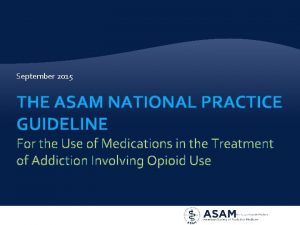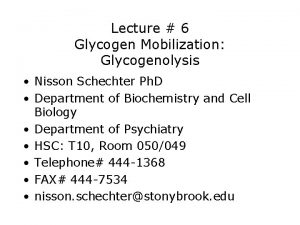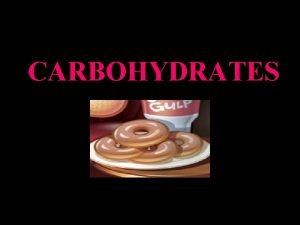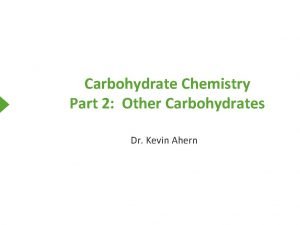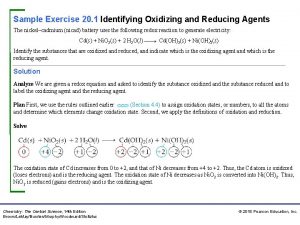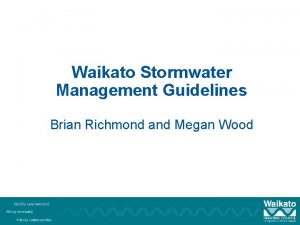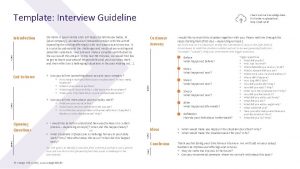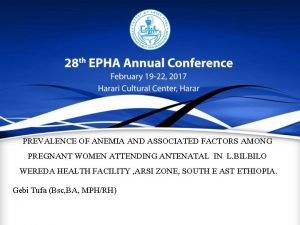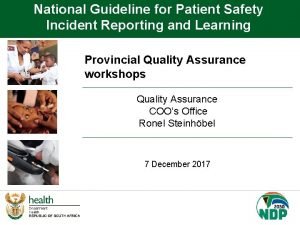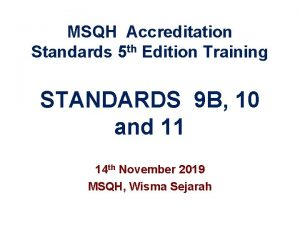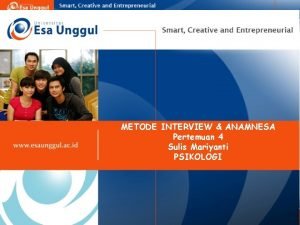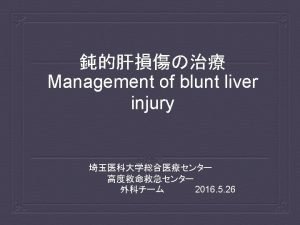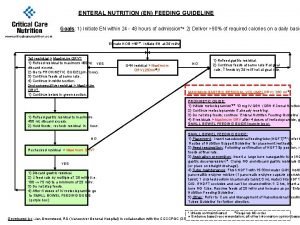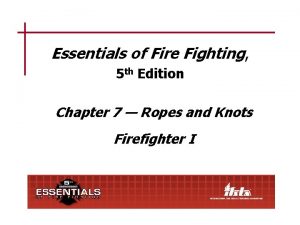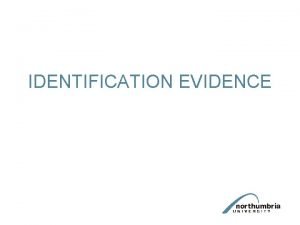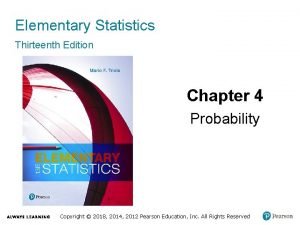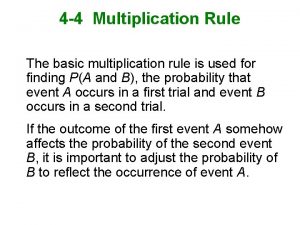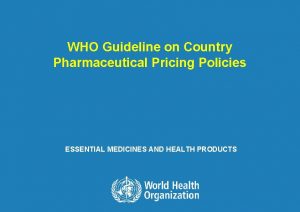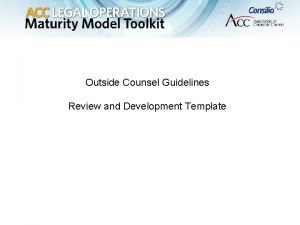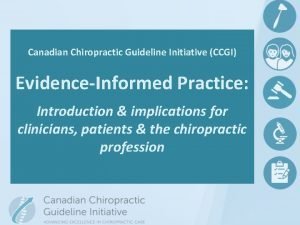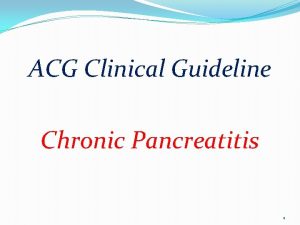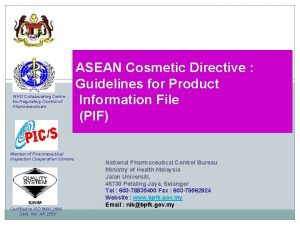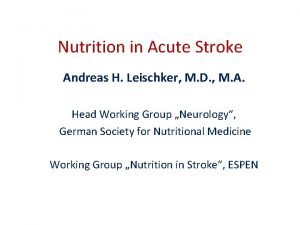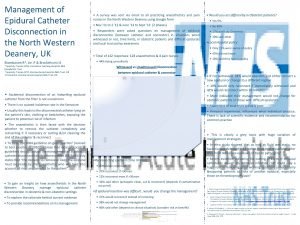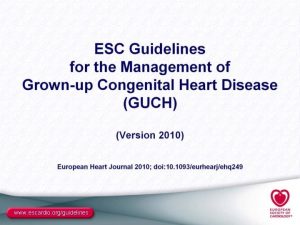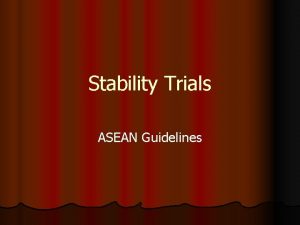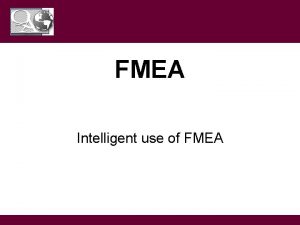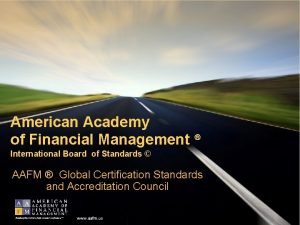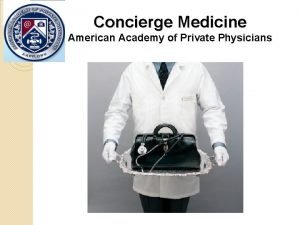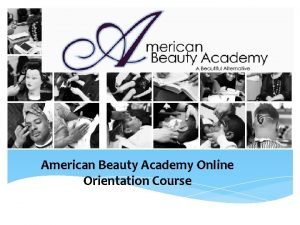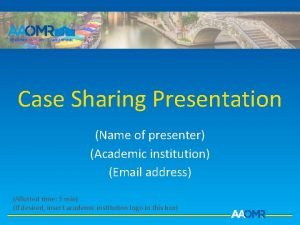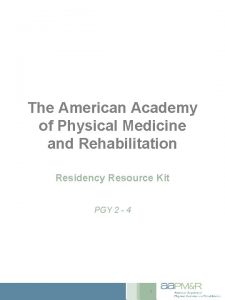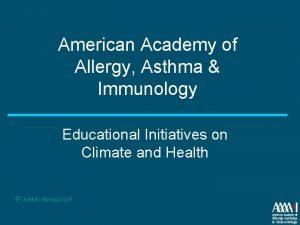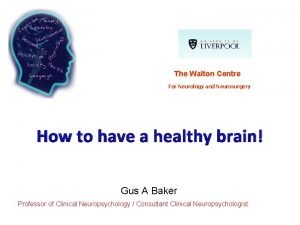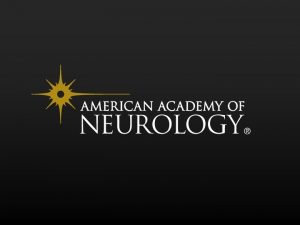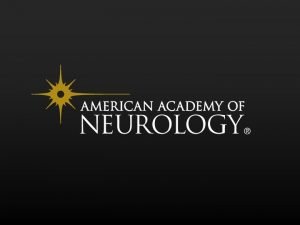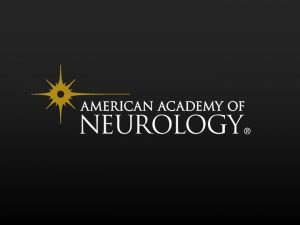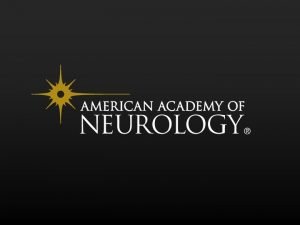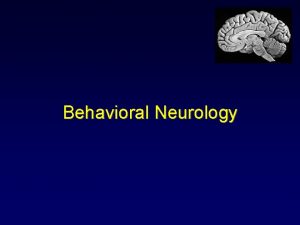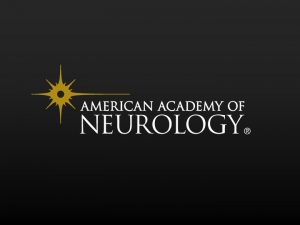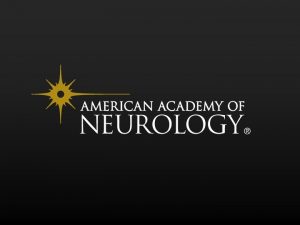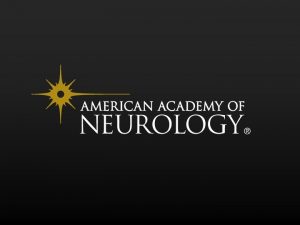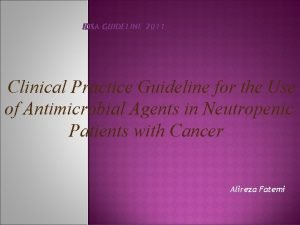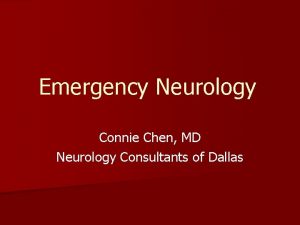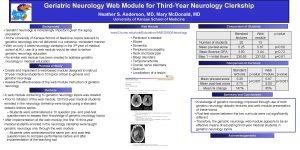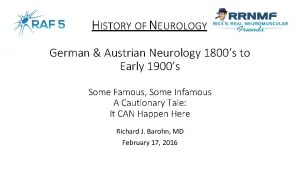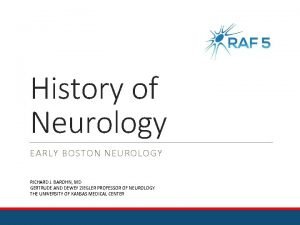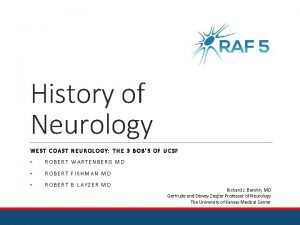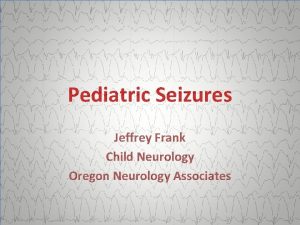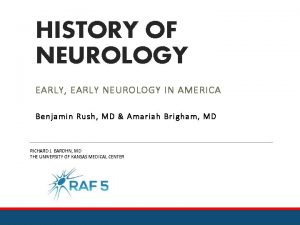2016 American Academy of Neurology Practice Guideline Reducing









































- Slides: 41

© 2016 American Academy of Neurology

Practice Guideline Reducing Brain Injury after Cardiopulmonary Resuscitation Report by: Guideline Development, Dissemination, and Implementation Subcommittee of the American Academy of Neurology © 2016 American Academy of Neurology

Guideline Funding This guideline was developed with financial support from the American Academy of Neurology. Authors who serve or served as AAN subcommittee members or methodologists (M. J. A. , A. R. , R. M. D. , J. L. ) were reimbursed by the AAN for expenses related to travel to subcommittee meetings where drafts of manuscripts were reviewed. © 2016 American Academy of Neurology Slide 2

Sharing This Information The American Academy of Neurology (AAN) develops these presentation slides as educational tools for neurologists and other health care practitioners. You may download and retain a single copy for your personal use. Please contact guidelines@aan. com to learn about options for sharing this content beyond your personal use. © 2016 American Academy of Neurology Slide 3

Guideline Objectives To assess the evidence for the acute therapeutic interventions that are provided to reduce brain injury in adult patients who are comatose after successful cardiopulmonary resuscitation and to make evidence-based recommendations. © 2016 American Academy of Neurology Slide 4

Overview § Introduction § Clinical questions § AAN guideline process § Methods § Conclusions § Practice recommendations © 2016 American Academy of Neurology Slide 5

Introduction § Outcomes for patients after nontraumatic cardiac arrest are dismal § Only 6%-9. 6% of all patients with out-of-hospital cardiac arrest (OHCA) survive to hospital dischargee 1, e 2 § An estimated 22. 3% of patients with in-hospital cardiac arrest (IHCA) survive to hospital dischargee 3 § It is recognized that brain injury related to cardiac arrest is a major § § determinant of mortality and disability. e 3 Until recently, the postresuscitation acute management of survivors of cardiac arrest was directed mainly toward the systemic injury, and acute neurologic care focused mainly on prognostication, with some supportive care of neurologic complications. Recently, there has been resurgence of interest in providing acute neuroprotective interventions directed primarily at the brain injury to improve survival and independence of survivors. e 4 © 2016 American Academy of Neurology Slide 6

Clinical Question This practice guideline addresses the following questions: 1. In patients with nontraumatic cardiac arrest, does induced mild therapeutic hypothermia (TH) or targeted temperature management (TTM) improve outcome after CPR in adults who are initially comatose? 2. In patients with nontraumatic cardiac arrest, do putative neuroprotective drugs improve outcome after CPR in adults who are initially comatose? 3. In patients with nontraumatic cardiac arrest, do other medical interventions or combinations of interventions improve outcome after CPR in adults who are initially comatose? © 2016 American Academy of Neurology Slide 7

AAN Guideline Process* • Clinical Question • Evidence • Conclusions • Recommendations *Guideline developed using the 2004 AAN Clinical Practice Guideline Process Manual. © 2016 American Academy of Neurology Slide 8

Literature Search/Review Rigorous, Comprehensive, Transparent 447 abstracts 36 rated articles © 2016 American Academy of Neurology Three databases (MEDLINE, Embase, and Science Citation Index) were searched from 1966 to March 2014. An updated identical search was performed to include articles published from March 2014 to August 2016. Inclusion criteria: Exclusion criteria: • Randomized controlled trials • Nonrandomized trials including patients receiving and not receiving the intervention • Review articles • Case reports Slide 9

AAN Classification of Evidence (2004) Therapeutic Scheme Class I • Prospective, randomized, controlled clinical trial with masked outcome assessment, in a representative population. The following are required: a) primary outcome(s) clearly defined b) exclusion/inclusion criteria clearly defined c) adequate accounting for dropouts and crossovers with numbers sufficiently low to have minimal potential for bias d) relevant baseline characteristics are presented and substantially equivalent among treatment groups or there is appropriate statistical adjustment for differences. © 2016 American Academy of Neurology Class II • Prospective matched group cohort study in a representative population with masked outcome assessment that meets a–d above OR an RCT in a representative population that lacks one criteria a–d. Slide 10

AAN Classification of Evidence (2004) Therapeutic Scheme Class III Class IV • All other controlled trials (including well-defined natural history controls or patients serving as own controls) in a representative population, where outcome is independently assessed, or independently derived by objective outcome measurement. * • Evidence from uncontrolled studies, case series, case reports, or expert opinion. *Objective outcome measurement: an outcome measure that is unlikely to be affected by an observer’s (patient, treating physician, investigator) expectation or bias (e. g. , blood tests, administrative outcome data). © 2016 American Academy of Neurology Slide 11

AAN Classification of Recommendations Level A • Established as effective, ineffective, or harmful (or established as useful/predictive or not useful/predictive) for the given condition in the specified population. • Requires at least two consistent Class I studies. Level B • Probably effective, ineffective, or harmful (or probably useful/predictive or not useful/predictive) for the given condition in the specified population. • Requires at least one Class I study or two consistent Class II studies. Level C • Possibly effective, ineffective, or harmful (or possibly useful/predictive or not useful/predictive) for the given condition in the specified population. • Requires at least one Class II study or two consistent Class III studies. Level U • Data inadequate or conflicting; given current knowledge, treatment (test, predictor) is unproven. • Studies not meeting criteria for Class I–III. © 2016 American Academy of Neurology Slide 12

Clinical Question 1 • In patients with nontraumatic cardiac arrest, does induced mild therapeutic hypothermia (TH) or targeted temperature management (TTM) improve outcome after CPR in adults who are initially comatose? © 2016 American Academy of Neurology Slide 13

Analysis of Evidence Initial cardiac rhythm: VT/VF • For patients who are comatose and in whom the initial cardiac rhythm is • • either ventricular tachycardia (VT) or ventricular fibrillation (VF) after cardiac arrest, TH (32°C– 34°C for 24 hours) is highly likely to be effective in improving neurologic outcome and survival compared with normothermia (2 Class I studies). For patients who are comatose and in whom the initial cardiac rhythm is either VT/VF or pulseless electrical activity (PEA)/asystole after cardiac arrest, TTM (36°C for 24 hours followed by 8 hours of rewarming to 37°C and temperature maintenance below 37. 5°C until 72 hours) is likely as effective as TH in improving neurologic outcome and survival (1 Class I study). For patients who are comatose and in whom the initial rhythm is VF after cardiac arrest, there is insufficient evidence to support or refute the use of 32°C vs 34°C TH because of lack of statistical precision (6 Class III studies). © 2016 American Academy of Neurology Slide 14

Analysis of Evidence Initial cardiac rhythm: PEA/asystole • For patients who are comatose and in whom the initial cardiac rhythm is either PEA or asystole after cardiac arrest, treatment with TH vs nonhypothermia treatment possibly improves survival to hospital discharge (RD 12%, 95% CI 8%– 16%, I 2 = 49; meta-analysis of 5 Class III studies) and good neurologic outcome at hospital discharge (RD 6%, 95% CI 3%– 9%, I 2 = 41; meta-analysis of 7 Class III studies). © 2016 American Academy of Neurology Slide 15

Analysis of Evidence Prehospital cooling • For patients who are comatose and in whom the initial cardiac rhythm is VT/VF or PEA/asystole after cardiac arrest, prehospital cooling with 2 L 4°C IV solutions or intranasal cooling as an adjunct to in-hospital cooling is highly likely to be ineffective in further improving neurologic outcome and survival (multiple Class I studies). © 2016 American Academy of Neurology Slide 16

Analysis of Evidence Studies comparing different cooling methods • In patients who are comatose with cardiac arrest, there is insufficient evidence to support or refute the use of invasive cooling methods (including endovascular catheter or peritoneal lavage) instead of surface cooling (single Class III studies). © 2016 American Academy of Neurology Slide 17

Analysis of Evidence Standardized protocols • In patients who are comatose after cardiac arrest, there is insufficient evidence to support or refute the use of a standardized protocol of care for the provision of TH. © 2016 American Academy of Neurology Slide 18

Analysis of Evidence Induced mild hypothermia in combination with coenzyme Q 10 • In patients who are comatose after out-of-hospital cardiac arrest (OHCA), the addition of coenzyme Q 10 to TH possibly improves survival but does not improve neurologic status at 3 months (1 Class II study). © 2016 American Academy of Neurology Slide 19

Analysis of Evidence Induced mild hypothermia in combination with high-dose erythropoietin • There is insufficient evidence to support or refute the use of epoetin alfa to improve outcome after induced mild hypothermia in patients who are comatose after cardiac arrest (1 Class III study). © 2016 American Academy of Neurology Slide 20

Clinical Question 2 • In patients with nontraumatic cardiac arrest, do putative neuroprotective drugs improve outcome after CPR in adults who are initially comatose? © 2016 American Academy of Neurology Slide 21

Analysis of Evidence Xenon gas • In patients with witnessed OHCA, VT/VF, and return of spontaneous circulation (ROSC), xenon (to achieve an end-tidal xenon concentration of at least 40%) and TH probably results in less white matter damage as measured by fractional anisotropy (1 Class I study), but the clinical importance of this is unknown. It probably does not improve 6 -month neurologic outcome as measured by the Cerebral Performance Category (CPC) (1 Class I study). Impacts on 6 -month mortality are uncertain (1 Class I study with insufficient precision). © 2016 American Academy of Neurology Slide 22

Analysis of Evidence Calcium channel blockers • In patients with OHCA of presumed cardiac origin and ROSC, there is insufficient evidence to support or refute the use of nimodipine (1 Class I study with insufficient statistical precision; Level U). In patients with cardiac arrest and ROSC, the calcium channel blocker lidoflazine is likely to be ineffective in improving survival and neurologic outcome (1 Class I study). © 2016 American Academy of Neurology Slide 23

Analysis of Evidence Thiopental • In patients with cardiac arrest and ROSC, a single loading dose of thiopental is likely to be ineffective in improving survival or neurologic outcome (1 Class I study). © 2016 American Academy of Neurology Slide 24

Analysis of Evidence Selenium • There is insufficient evidence to support or refute the effectiveness of selenium in improving outcome (1 Class III study). © 2016 American Academy of Neurology Slide 25

Analysis of Evidence Magnesium and diazepam • In patients with OHCA, there is insufficient evidence to support or refute the use of a single 2 g loading dose of magnesium sulfate for improving survival or awakening (1 Class I study with insufficient statistical precision to exclude a meaningful benefit). • On the basis of the same study, a single 10 mg loading dose of diazepam is likely to be ineffective in improving survival or awakening. © 2016 American Academy of Neurology Slide 26

Analysis of Evidence Corticosteroids • In patients with OHCA, there is insufficient evidence to support or refute the use of corticosteroids for improving survival or neurologic outcome (1 Class II study and 1 Class III study with insufficient statistical precision to exclude a moderate or large benefit). © 2016 American Academy of Neurology Slide 27

Clinical Question 3 • In patients with nontraumatic cardiac arrest, do other medical interventions or combinations of interventions improve outcome after CPR in adults who are initially comatose? © 2016 American Academy of Neurology Slide 28

Analysis of Evidence Oxygen therapy • There is insufficient evidence to support or refute the use of 100% oxygen for 60 minutes immediately post resuscitation in patients with OHCA and ROSC (1 Class I study with insufficient statistical precision to exclude a potentially important clinical effect). © 2016 American Academy of Neurology Slide 29

Analysis of Evidence High-volume hemofiltration • There is insufficient evidence to support or refute the use of isovolumic high-volume hemofiltration (HF) in patients with OHCA and ROSC (1 Class I study with insufficient statistical precision for the primary analysis of 6 -month survival and with a secondary logistic regression model including a lower CI of uncertain clinical relevance). © 2016 American Academy of Neurology Slide 30

Recommendations Level A © 2016 American Academy of Neurology • For patients who are comatose and in whom the initial cardiac rhythm is either VT or VF after cardiac arrest, TH (32°C– 34°C for 24 hours) is highly likely to be effective in improving neurologic outcome and survival compared with normothermia and should be offered (Level A). • For patients who are comatose and in whom the initial cardiac rhythm is VT/VF or PEA/asystole after cardiac arrest, prehospital cooling with 2 L 4°C IV solutions or intranasal cooling as an adjunct to in-hospital cooling should not be offered (Level A). Slide 31

Recommendations Level B © 2016 American Academy of Neurology • For patients who are comatose and in whom the initial cardiac rhythm is either VT/VF or PEA/asystole after cardiac arrest, TTM (36°C for 24 hours followed by 8 hours of rewarming to 37°C and maintained below 37. 5°C until 72 hours) is likely as effective as TH in improving neurologic outcome and survival and is an acceptable alternative to TH (Level B). • In patients with cardiac arrest and ROSC, the calcium channel blocker lidoflazine is likely to be ineffective in improving survival and neurologic outcome and should not be offered (Level B). • In patients with cardiac arrest and ROSC, a single loading dose of thiopental is likely to be ineffective in improving survival or neurologic outcome and should not be offered (Level B). • A single 10 mg loading dose of diazepam is likely to be ineffective in improving survival or awakening and should not be offered (Level B). Slide 32

Recommendations Level C © 2016 American Academy of Neurology • Although the frequency of survival and good neurologic outcome after nonshockable rhythms is small, for patients who are comatose and in whom the initial cardiac rhythm is either PEA or asystole after cardiac arrest, TH possibly improves survival and good neurologic recovery at discharge compared with standard care and may be offered (Level C). • In patients who are comatose after cardiac arrest, the addition of coenzyme Q 10 to TH possibly improves survival but does not improve neurologic status at 3 months and may be offered (Level C). Slide 33

Recommendations Level U © 2016 American Academy of Neurology • No recommendations are made on the use of 32°C vs 34°C TH; use of TH in patients whose initial cardiac rhythm is PEA or asystole; use of invasive cooling instead of surface cooling; use of standardized protocols for TH; or use of epoetin alfa in addition to mild TH (Level U). • In patients with OHCA of presumed cardiac origin and ROSC, there is insufficient evidence to support of refute the use of nimodipine, selenium, a single 2 -g loading dose of magnesium sulfate, or corticosteroids for improving survival or neurologic outcome (Level U). • In patients with witnessed OHCA, VT/VF, and ROSC, there is insufficient evidence to support or refute the routine clinical use of xenon gas in addition to TH, as it probably results in less white matter damage as measured by fractional anisotropy, but the clinical importance of this is unknown and it probably does not improve 6 -month neurologic outcome as measured by the CPC. Further research into the clinical outcomes of this intervention is warranted. • There is insufficient evidence to support or refute the use of 100% oxygen for 60 minutes immediately post resuscitation in patients with OHCA and ROSC (Level U). There is insufficient evidence to support or refute the use of isovolumic high-volume HF (with or without TH) in patients with OHCA and ROSC (Level U). Slide 34

Recommendations for Future Research Future research needs to carefully address the complexity of patient characteristics and the clinical course after from cardiac arrest. Precise definitions of coma, outcomes, and the decision for withdrawal of life-sustaining therapy are needed. Future research questions may include the following: 1. What are the best assessment methods and outcome measures to use? When is the best time to use these methods and measures? 2. What is the beneficial effect of TH and TTM on patients resuscitated from IHCA with all types of initial cardiac rhythm? 3. What are optimal temperature settings (time initiating and reaching target temperature, rate of rewarming, depth of target temperature [e. g. , 32°C, 34°C, 36°C], duration of temperature management [e. g. , 12 hours, 24 hours, 48 hours]) to provide the best outcome? © 2016 American Academy of Neurology Slide 35

Recommendations for Future Research (continued) 4. What is the treatment window (time lapse after ROSC) in which TTM will be most effective and ineffective? 5. What is the role of fever control over days after active TTM? 6. What strategies (e. g. , ECMO, pharmacologic agents) may provide benefit in addition to hypothermia, and what is the impact of hypothermia on the action of other putative neuroprotective agents or interventions? 7. What are the best and safest methods of delivering hypothermia (external vs internal, global vs regional cooling)? 8. What is the impact of aggressive management of post–cardiac arrest neurologic complications (e. g. , brain edema, seizures or seizure prophylaxis, intracranial pressure elevation, and ICU-related complications) on outcomes? © 2016 American Academy of Neurology Slide 36

Recommendations for Future Research (continued) 9. What is the impact of aggressive management of the etiology of cardiac arrest (e. g. , myocardial infarction) and aggressive management of other systemic complications? 10. How does the use of TH affect the ability to prognosticate outcome in patients who are comatose after cardiac arrest? 11. What is the role of TTM induced and maintained by pharmacologic means in patients who are comatose after ROSC? 12. What is the role of biomarkers in the delivery and maintenance of TTM and the impact of biomarkers on prognostication? 13. What is the role of withdrawal of life-sustaining therapies in the outcomes of studies related to cardiac arrest resuscitation? © 2016 American Academy of Neurology Slide 37

References cited here can be found in the complete guideline, an online data supplement to the summary article. To locate these materials, please visit AAN. com/guidelines. © 2016 American Academy of Neurology Slide 38

Access Guideline and Summary Tools • To access the complete guideline and related summary tools, visit AAN. com/guidelines. • Summary guideline article • Complete guideline article (available as a data supplement to the published summary) • Summary for clinicians and summary for patients/families © 2016 American Academy of Neurology Slide 39

Questions? © 2016 American Academy of Neurology
 Asam national practice guideline
Asam national practice guideline Kdigo 2012 aki
Kdigo 2012 aki Cushing syndrome mnemonic
Cushing syndrome mnemonic Reducing and non reducing sugar
Reducing and non reducing sugar Fates of glucose 6 phosphate
Fates of glucose 6 phosphate Osazone test diagram
Osazone test diagram Reducing sugar vs non reducing sugar
Reducing sugar vs non reducing sugar Identify oxidizing and reducing agents practice
Identify oxidizing and reducing agents practice Microsoft office 2016 in practice
Microsoft office 2016 in practice Waikato stormwater management guideline
Waikato stormwater management guideline Interview guideline template
Interview guideline template Anemia in pregnancy guideline
Anemia in pregnancy guideline Autoanamnesa
Autoanamnesa Patient safety incident policy
Patient safety incident policy Msqh guideline
Msqh guideline Guideline anamnesa
Guideline anamnesa East practice management guidelines
East practice management guidelines Enteral feeding guideline
Enteral feeding guideline Parts of haircutting shears milady
Parts of haircutting shears milady What is a guideline for hoisting a hoseline?
What is a guideline for hoisting a hoseline? Turnbull warning
Turnbull warning Elementary statistics chapter 4
Elementary statistics chapter 4 5% guideline for cumbersome calculations
5% guideline for cumbersome calculations Who guideline on country pharmaceutical pricing policies
Who guideline on country pharmaceutical pricing policies Outside counsel billing guideline creation
Outside counsel billing guideline creation Canadian chiropractic guideline initiative
Canadian chiropractic guideline initiative Acg chronic pancreatitis
Acg chronic pancreatitis Bpfk cosmetic guideline
Bpfk cosmetic guideline Leischker
Leischker Disconnected epidural catheter guideline
Disconnected epidural catheter guideline Escardio guideline
Escardio guideline Asean stability guideline
Asean stability guideline Srm process flow
Srm process flow Fmea guideline
Fmea guideline American academy of financial management
American academy of financial management American academy of private physicians
American academy of private physicians Beauty academy online course
Beauty academy online course American academy of oral and maxillofacial radiology
American academy of oral and maxillofacial radiology American academy of witchcraft arts
American academy of witchcraft arts American academy of physical medicine and rehabilitation
American academy of physical medicine and rehabilitation American academy of allergy asthma and immunology 2018
American academy of allergy asthma and immunology 2018 Walton centre for neurology
Walton centre for neurology
